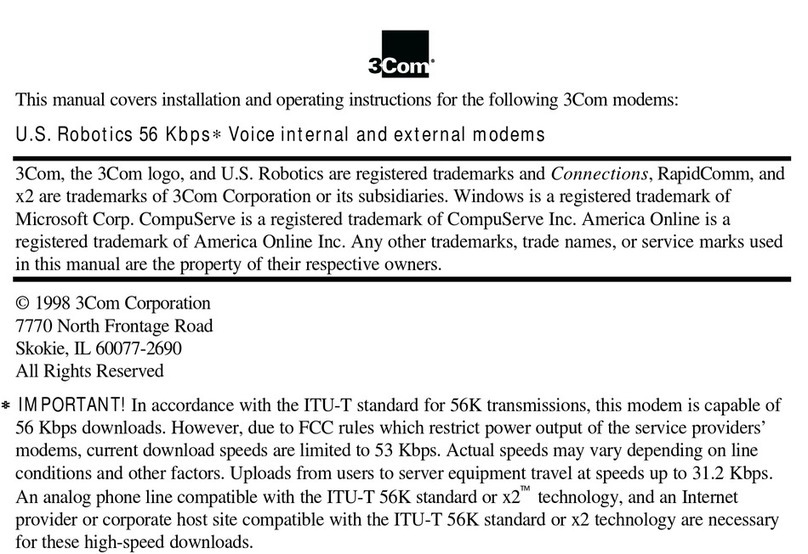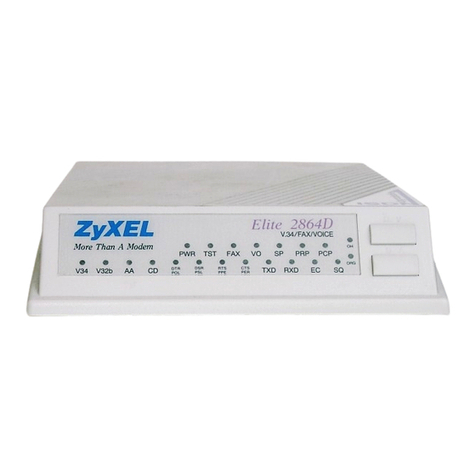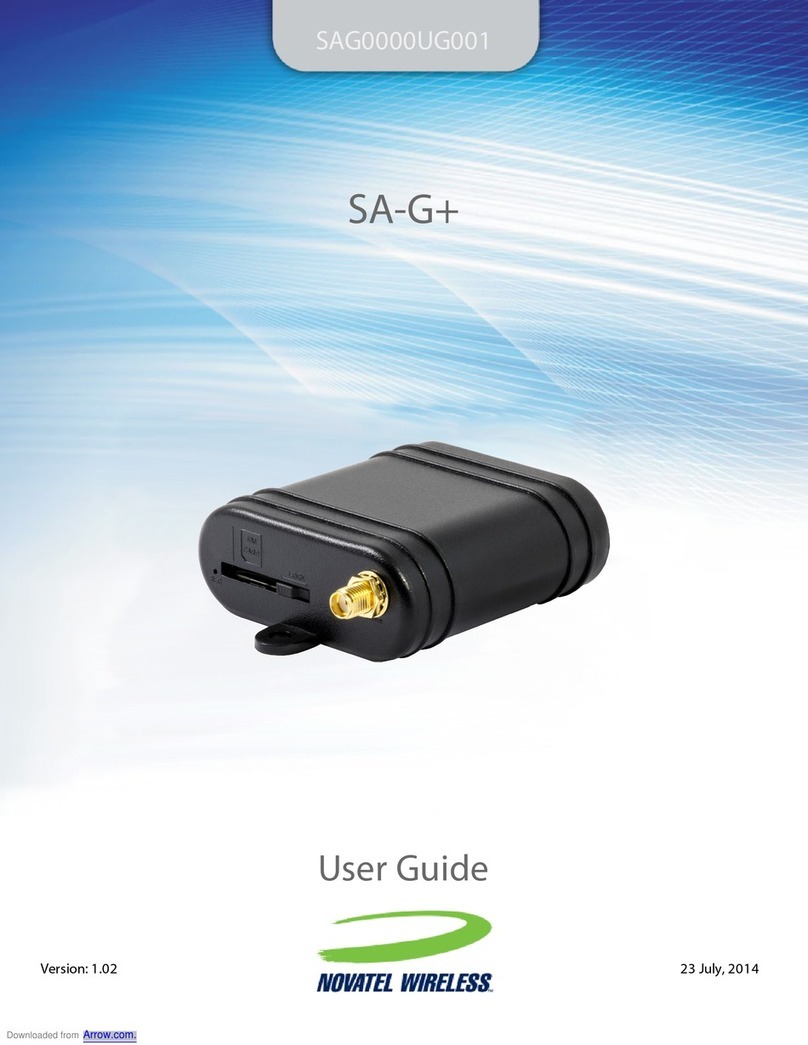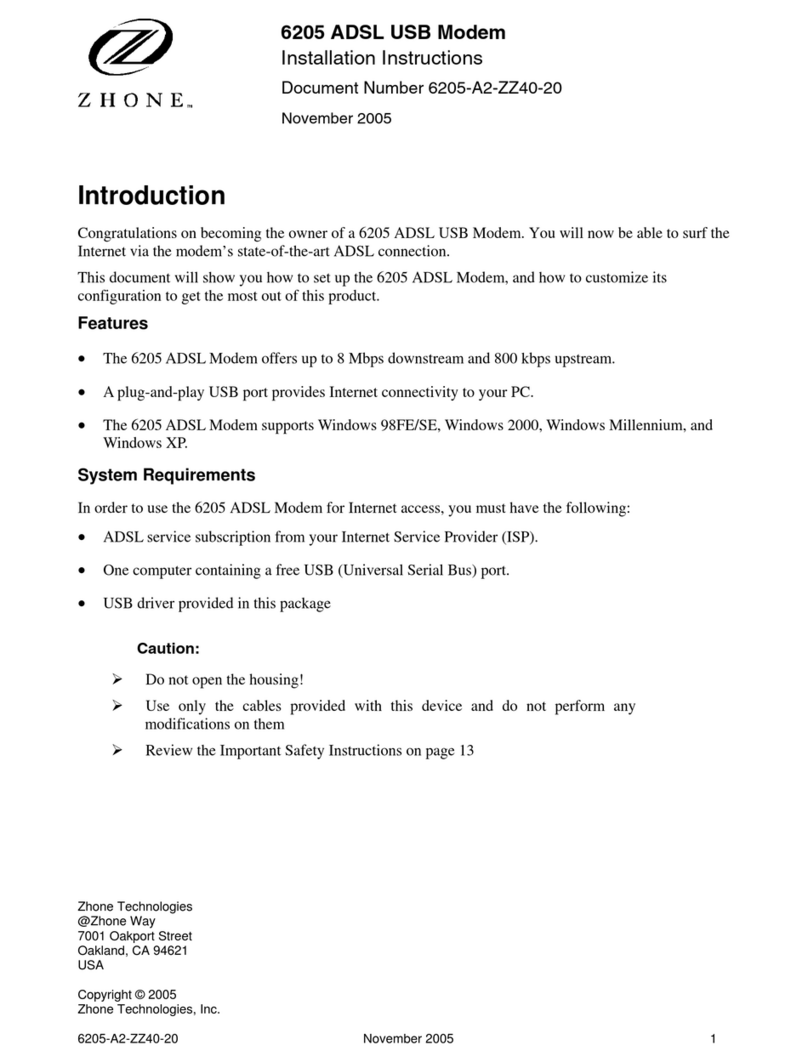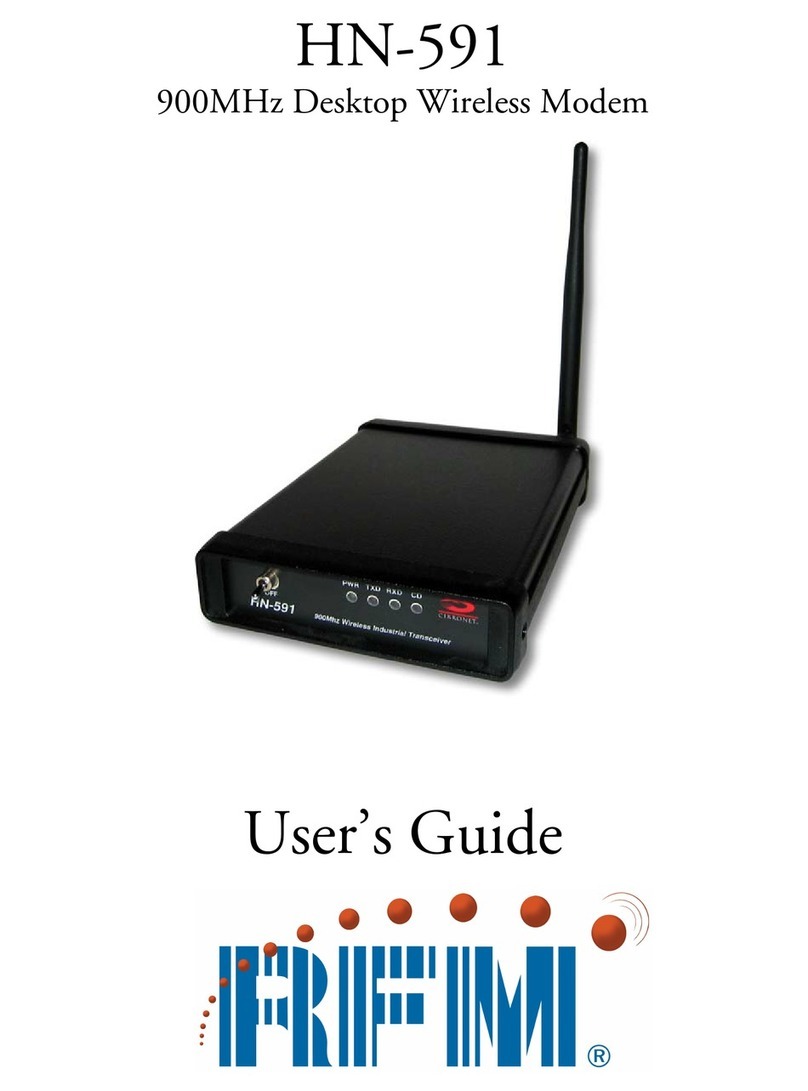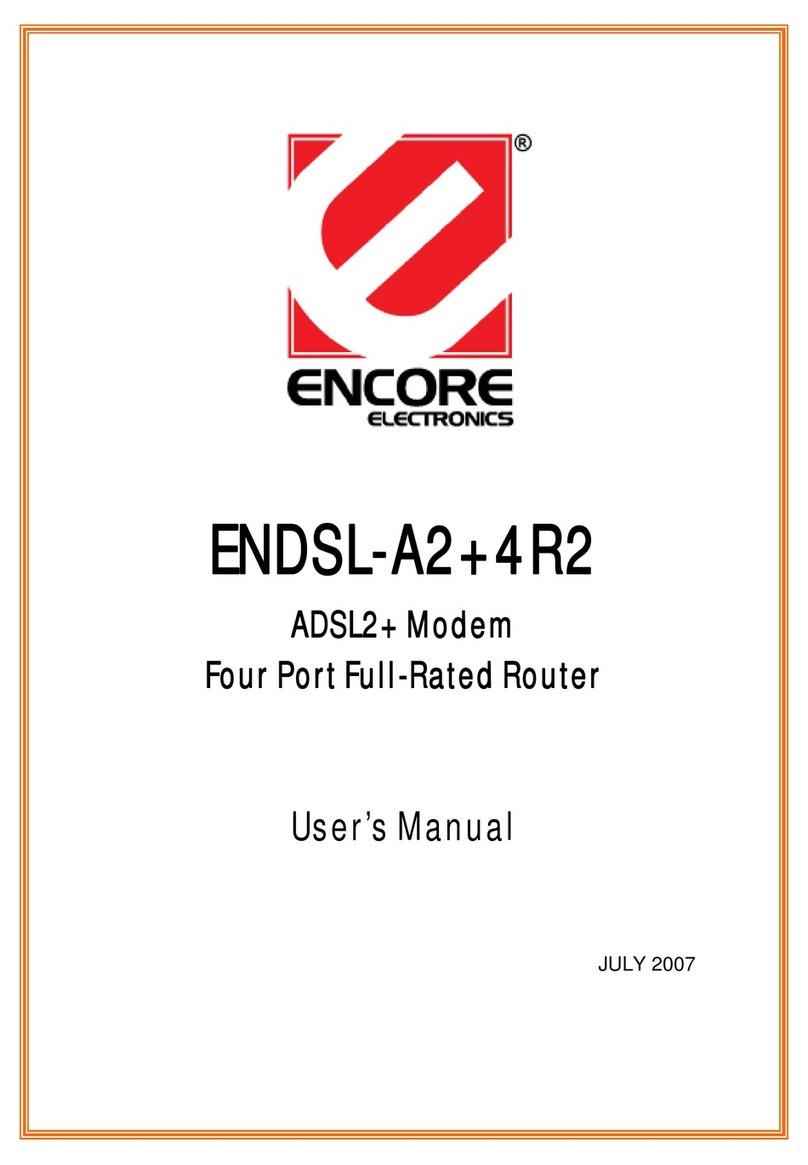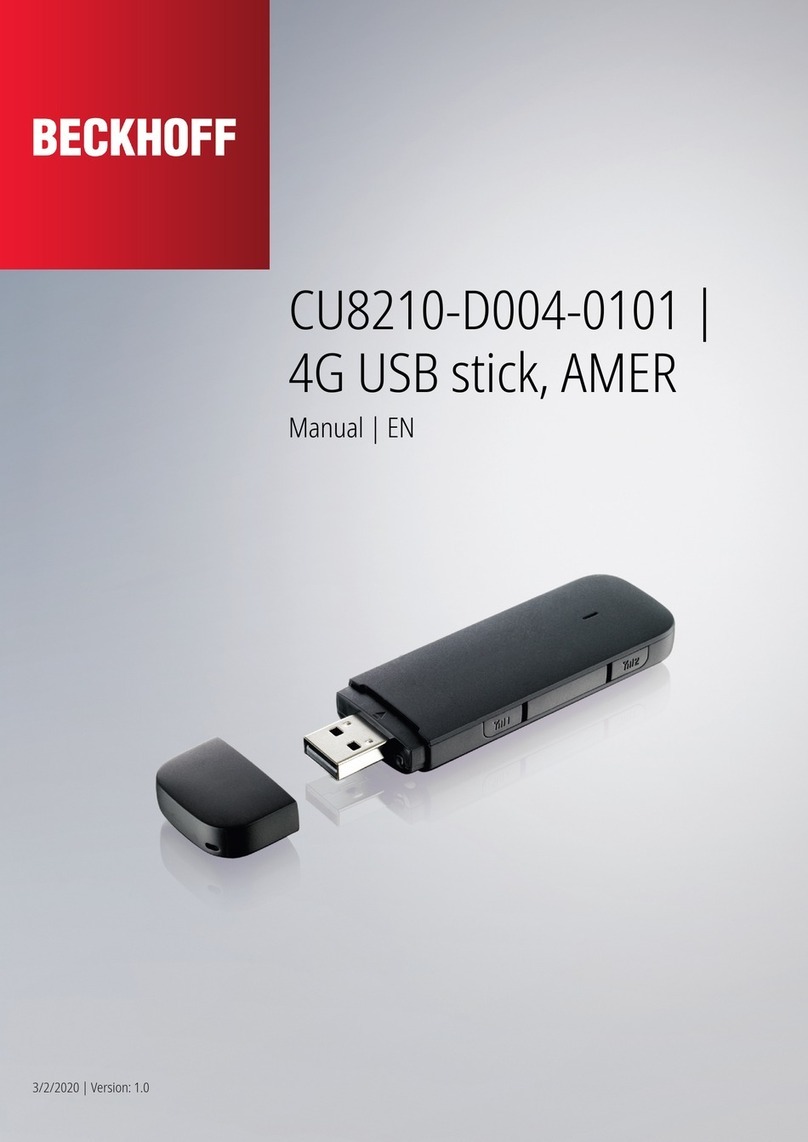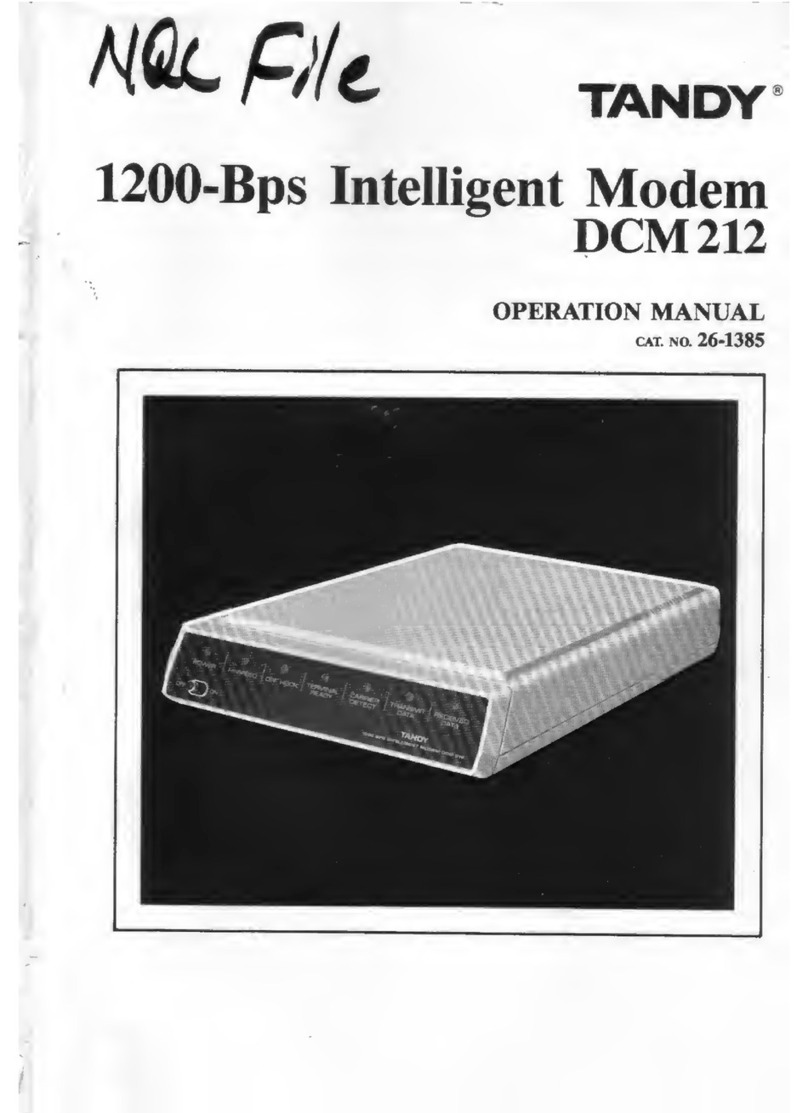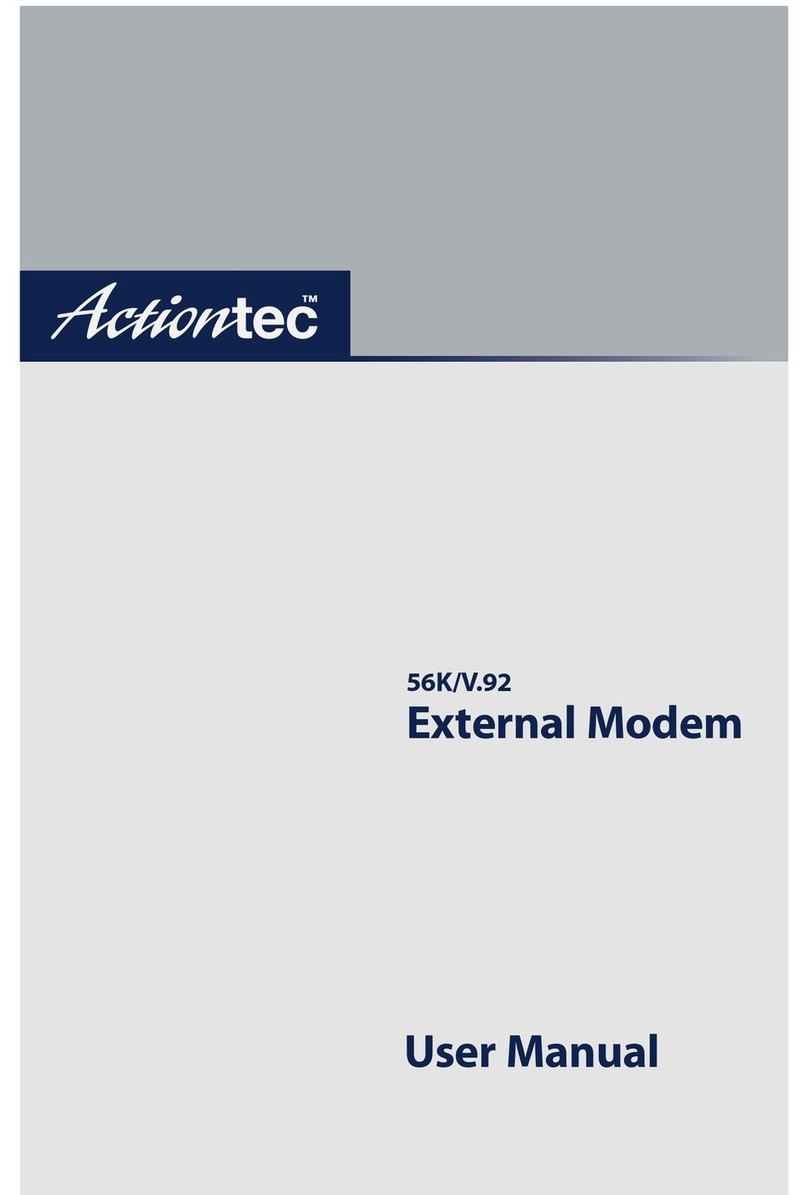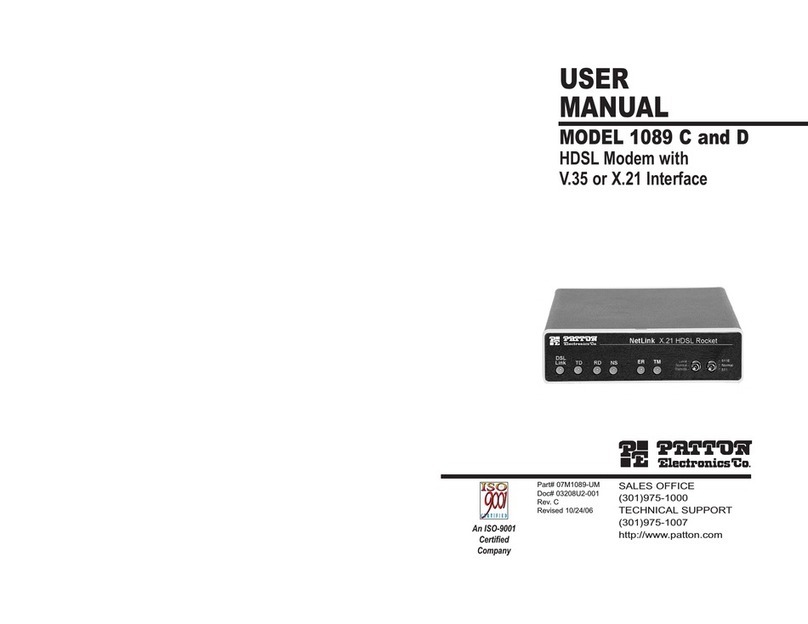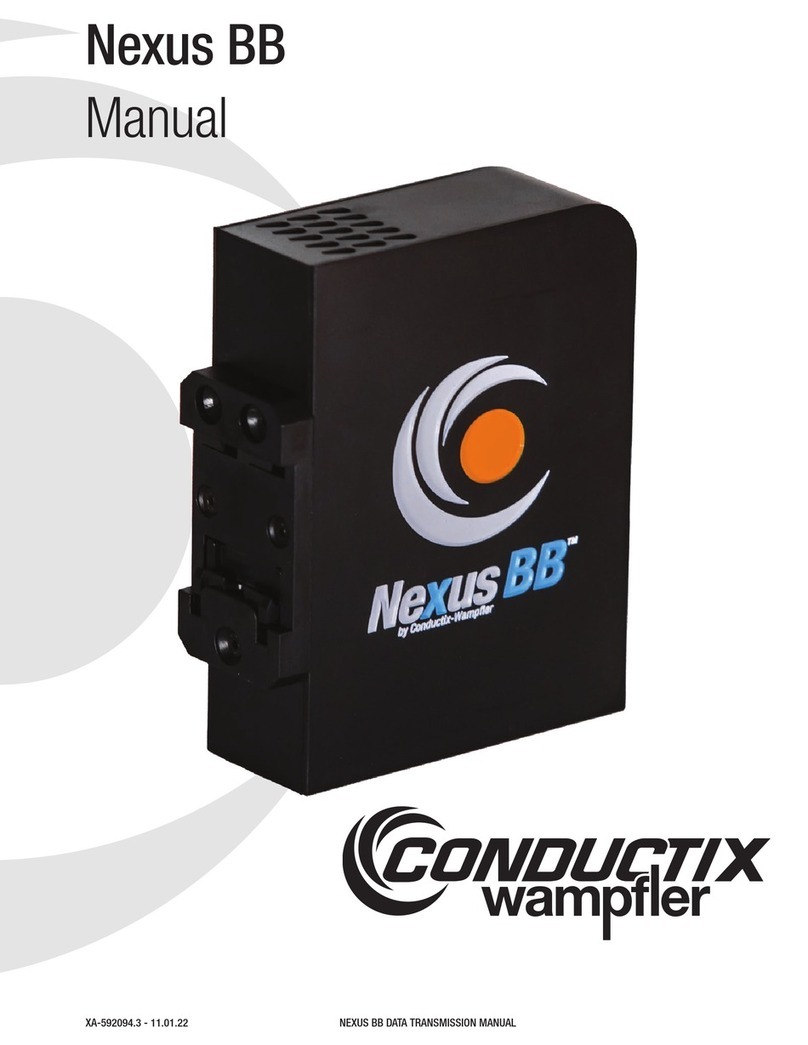I-DEN iO1000 Operating and maintenance manual

iO1000
Wireless Modem
Detailed Service Manual
7 OCT 1999
¤
68P02953C80-O

Manual Revisions
Changes that occur after this manual is printed are described in the Field Manual Revisions (FMRs). The FMRs provide the
most current instructions and component information.
Copyright Information
Motorola products described in this manual may include copyrighted Motorola computer programs stored in semiconductor
memories or other media. Laws in the United States and other countries preserve for Motorola certain exclusive rights for
copyrighted computer programs, including the exclusive right to copy or reproduce in any form the copyrighted computer
program. Accordingly, any copyrighted Motorola computer programs contained in the Motorola products described in this
manual may not be copyrighted or reproduced in any manner without the express written permission of Motorola. Further-
more, the purchase of Motorola products shall not be deemed to grant either directly or by implication, estoppel, or otherwise,
any license under the copyrights, patents, or patent applications of Motorola, except for the normal non-exclusive royalty-free
license to use that arises by operation of law in the sale of the product.
Trademarks
The following is a registered trademark of Motorola, Inc.:
¥
iDEN
® Reg. U.S. Pat. & Tm. Off.
All other trademarks mentioned in this manual are trademarks of their respective companies.
Patent Information
This product is protected under one or more of the following patents:
4817157, 4896361, 4857928, 5041793, 5060294, 5066923, 5134718, 5140156, 5239963, 5257411, 5287387, 5265219,
5289504, 5316168, 5317247, 5338396, 5389927, 5406588, 5424921, 5457376, 5460906, 5551063, 5557079, 5596487,
5615412, 5638403, 5559468, 5469465, 5170413, 5140615, 5519730, 5241544, 5584059, 5574992, 5396656, 5487091,
5533004, 5299199, 5343499, 5369501, 5509031, 5515379, 5528723, 5598417, 5066923, 5241650, 5278833, 5359696,
5548631, 5410632, 5440582, 5457735, 5457818, 5471670, 5477550, 5481537, 5566181, 5229767, 5208804, 5295140,
5381449, 5440590, 5467398, 5490230, 5620242, 5623523, 5655913
© Copyright 1999, Motorola, Inc. All rights reserved.

iii
For the Safe and Efficient Operation ofYour Radio, Observe these Guidelines:
Your radio contains a transmitter and a receiver. When
it is
ON
, it receives and transmits radio frequency
(RF) energy. The radio operates in the frequency
range of 806 MHz to 866 MHz and employs digital
modulation techniques. This product is authorized
under FCC Rule Part 47CFR 2. 1091 (b), which states
that it should be used in such a way that a separation
distance of at least 8 inches (20 cms) is normally
maintained between the radio’s antenna and the body
of the user or nearby persons. When you use your
radio product, the system handling your call, controls
the power level at which your radio product transmits.
The output power level typically may vary over a
range from 0.0024 watts to 0.7 watts.
ExposureTo Radio Frequency Energy
Your Motorola Radio Product is designed to comply
with the following national and international
standards and guidelines regarding exposure of
human beings to radio frequency electromagnetic
energy:
• United States Federal Communications
Commission, Code of Federal Regulations; 47
CFR part 2 sub-part J
• American National Standards Institute (ANSI)
IEEE. C95. 1-1992
• National Council on Radiation Protection and
Measurements (NCRP). Report 86
• International Commission on Non-Ionizing
Radiation Protection (ICNIRP) 1998
• European Committee for Electrotechnical
Standardization (CENELEC), ENV 50166-2,
1995 E
• National Radiological Protection Board of the
United Kingdom,
GS 11, 1988
• Verband Deutscher Elektrotechniker (VDE) DIN-
0848
• Department of Health and Welfare Canada.
Safety Code 6
Antenna and Installation Considerations
• All equipment must be properly installed in
accordance with Motorola installation instructions.
• To assure compliance with United States FCC
regulations on RF exposure, the user of the
equipment must position the antenna in such a way
to maintain a separation of at least 8 inches (20
cms) between the antenna and the body of any user
and nearby person.
• Ensure that the antenna is properly installed
external to the vehicle and in accordance with the
requirements of the antenna manufacturer/supplier.
• Use only the supplied or an approved antenna.
Unauthorized antennas, modifications, or
attachments could impair call quality, damage the
modem, or result in violation of the ICNRP or the
FCC.
Interference to Medical and Personal
Electronic Devices
Most electronic equipment is shielded from RF
energy. However, certain equipment may not be
shielded against RF signals from your radio radio
product.
Pacemakers
Do not operate the radio when any person is within 6
inches (0.15 meters) of the antenna. That person may
be using a pacemaker, a hearing aid or other personal
electronic device which may not be adequately
shielded.
Hearing Aids
Some radio products may interfere with some hearing
aids. In the event of such interference, you may want
to consult your hearing aid manufacturer to discuss
alternatives.
Other Medical Devices
If you use any other personal medical device, consult
the manufacturer of your device to determine if it is
adequately shielded from external RF energy.Your
physician may be able to assist you in obtaining this
information.
SAFETY AND GENERAL INFORMATION
IMPORTANT INFORMATION ON SAFE AND EFFICIENT
OPERATION. READ THIS INFORMATION BEFORE USING YOUR
INTEGRATED MULTI-SERVICE RADIO PRODUCT.

iv
RF energy may affect improperly installed or
inadequately shielded electronic operating and
entertainment systems in motor vehicles. Check with
the manufacturer or representative to determine if
these systems are adequately shielded from external
RF energy. Also check with the manufacturer of any
equipment that has been added to the vehicle.
SAFETY AND GENERAL
USEWHILE DRIVING
Check the laws and regulations on the use of radio
products in the area where you drive.Always obey
them.
When using the radio product while driving, please:
• Give full attention to driving and to the road
• Pull off the road and park before using the
product if driving conditions so require.
POTENTIALLY EXPLOSIVE ATMOSPHERES
Turn off your radio product when you are in any area
with a potentially explosive atmosphere, unless it is a
radio product type especially qualified for use in such
areas (for example, Factory Mutual Approved).
Sparks in a potentially explosive atmosphere can
cause an explosion or fire resulting in bodily injury, or
even death.
Note:
The areas with potentially explosive atmospheres
referred to above include fueling areas such as: below
decks on boats; fuel or chemical transfer or storage
facilities; areas where the air contains chemicals or
particles such as grain, dust or metal powders; and
any other area where you would normally be advised
to turn off your vehicle engine. Areas with potentially
explosive atmospheres are often, but not always
posted.
Do not transport or store flammable gas, liquid, or
explosives in the compartment of your vehicle which
contains your radio or accessories.
In the United States, Vehicles powered by liquefied
petroleum gas (such as propane or butane) must
comply with the National Fire Protection Standard
(NFPA-58). For a copy of this standard, contact the
National Fire Protection Association. One
Batterymarch Park, Quincy, MA 02269, Attn:
Publications Sales Division.
!
W A R N I N G
!
!
W A R N I N G
!
OPERATIONAL
WARNINGS
INTERFERENCETO OTHER
ELECTRONIC DEVICES

v
BLASTING CAPS AND AREAS
To avoid possible interference with blasting
operations, turn off your radio product when you are
near electrical blasting caps, in a blasting area, or in
areas posted: "Turn off two-way radio". Obey all signs
and instructions.
FORVEHICLES EQUIPPEDWITH AN AIR BAG
An air bag inflates with great force. DO NOT place
objects, including communication equipment, in the
area over the air bag or in the air bag deployment area.
If the communication equipment is improperly
installed and the air bag inflates, this could cause
serious injury.
Installation of vehicle communication equipment
should be performed by a professional installer/
technician qualified in the requirements for such
installations. An air bag’s size, shape,and deployment
area can vary by vehicle make, model, and front
compartment configuration (for example, bench seat
vs. bucket seats).
Contact the vehicle manufacturer’s corporate
headquarters, if necessary, for specific air bag
information for the vehicle make, model, and front
compartment configuration involved in your
communication equipment installation.
DAMAGED ANTENNAS
Do not use any radio product with a damaged antenna.
If a damaged antenna comes into contact with your
skin, a minor burn can result.
CLEANING INSTRUCTIONS
Clean the external surfaces of the radio product with a damp
cloth, using a mild solution of dishwashing detergent and
water. Some household cleaners may contain chemicals that
could seriously damage the radio product. Avoid the use of
any petroleum-based solvent cleaners. Also, avoid applying
liquids directly on the radio product.
!
W A R N I N G
!
!
C a u t i o n
OPERATIONAL
WARNINGS
OPERATIONAL
CAUTION

vi
IMPORTANT INFORMATION
FOR EVERY MANUFACTURER TO WHOM THESE
PRODUCTS ARE RESOLD
iO1000 modems that we are supplying to you for
incorporation into the final product are components
that when connected to the power supply can receive
and transmit radio signals. In the United States, the
Federal Communications Commission requires that
many radio transmitting devices must obtain approval
before being offered on the market, unless the device
is exempt
While the iO1000 modem has been designed to meet
applicable FCC requirements, provided in the code of
Federal Regulation 47CER part II subpart J and
47CER part S, the Final Product’s compliance with
the FCC’s requirements, including RF energy expo-
sure requirements, must reflect product usage, posi-
tioning of the iO1000 within the product, the type of
antenna used, the,location of the antenna, and other
factors that may vary with the design and nature of the
Final Product. Therefore, compliance with such FCC
requirements can only be determined by an assess-
ment of the Final Product.
It is important that any manufacturer to whom the
iO1000 modem is resold for use in the Final Product
also recognize that he/she will have the responsibility
for taking all necessary steps to ensure that the Final
Product meets any applicable FCC requirements and
for obtaining any necessary approval from the FCC
for sale and operation of the Final Product. To the
extent that this may require development of user
information or guidance to be provided to each pur-
chaser of the Final Product, this will also be the
responsibility of the manufacturer.

vii
iO1000 Detailed Service Manual - MODEL SPECIFICATIONS FOR F2581A
MODEL SPECIFICATIONS FOR F2581A
Specifications subject to change without notice.
GENERAL RECEIVER TRANSMITTER
FCC Designation: Receiver Type: RF Pulse Avg. Power:
0.6 W
Temperature Range: Frequency Range:
851-866 MHz
Frequency Range:
Operating:
–25°C to +60°C
Bandwidth:
15 MHz 806-821 MHz
Storage (w/o battery):
–40°C to +85°C
Channel Spacing:
25 kHz
Frequency Stability:
Supply Voltage: Frequency Stability: Locked to base:
0.2 ppm
Nominal:
3.6 Vdc
Locked to base:
0.2 ppm
Not locked to base:
5 ppm
Range:
3.4 to 3.8 Vdc
Not locked to base:
5 ppm
Sensitivity (10%) BER: Spurious Emissions:
Dimensions (H x W x D)
111.5 x 56.5 x 27.5 mm
851-866 MHz:
– 111 dBm
Conducted:
– 43 dBW
Weight (with lithium battery):
126 g
Selectivity:
25 kHz Adjacent Channel:
60 dB
Radiated:
– 43 dBW
Modulation Type
Quad 4/16/64
QAM
Image (typical):
55 dB
Emissions Designator:
20K0D7W
Adjacent Channel
.
Power at +/-25kHz
-60dB

MODEL SPECIFICATIONS FOR F2581A
viii

1
iO1000 Detailed Service Manual - OVERVIEW
CHAPTER 1
OVERVIEW
INTRODUCTION
The iO1000
Detailed Service Manual
contains the information necessary to iden-
tify and fix problems in the iO1000 OEM Module. This unit is based on digital
technology and is designed to operate on integrated Digital-Enhanced Network
(iDEN) systems.
Service for the iO1000 unit is based on the substitution method: a faulty part is
replaced by a working one, providing quick service to the customer. For example,
if the battery is faulty, it is replaced. If the unit requires more complete testing or
service than is available at the basic level, it is sent to the field-level service facil-
ity, serviced, and returned to the iDEN Customer Care Center (ICC).
Note:
Before operating or testing this unit, please read the
Safety and General
Information
section in the front of this manual.
Digital Modulation Technology
The iO1000 is an 806-866 MHz unit that can operate in three modes:
dispatch
,
interconnect
, and
multi-service
. It uses two digital technologies: Quad 16QAM
and Time Division MultipleAccess (TDMA).
Quadrature Amplitude Modulation (QAM)
is a modulation technique that trans-
mits information by altering the amplitude and phase of the radio frequency (RF)
signal. Data is converted into complex symbols, which alter the RF signal and
transmit the information. When the signal is received, the amplitude and phase are
converted back into symbols and then into the original data.
In 16QAM, each of the 16 possible combinations of four bits is converted into a
unique amplitude and phase. The traditional 25 kHz channel used for two-way
radios is split into four 16QAM signals (subcarriers) that are transmitted simulta-
neously. This technique can transmit 64 kbps in a single 25 kHz channel.
The signal spectrum of the Quad 16QAM is shown in Figure 1 on page 2.

OVERVIEW: Digital ModulationTechnology
2
Figure 1. Spectrum of IDEN Quad 16QAM
Time Division Multiple Access (TDMA)
is used to allocate portions of the RF sig-
nal by dividing time into six slots, one for each unit. Time allocation enables each
unit to transmit its voice information without interference from another unit’s
transmission.
Transmission from a unit or base station is accommodated in time-slot lengths of
15 milliseconds and frame lengths of 90 milliseconds (see Figure 2 on page 3).
0-10-20 10 20
Frequency from Desired Channel Center
(kHz)
RL 0dBm 10 dB/
Power
(dB)
-10
-20
-30
-40
-50
-60
-70

3
iO1000 Detailed Service Manual - OVERVIEW
Figure 2. iDEN TDM Format
Note that
Rx
(outbound) indicates base-to subscriber transmissions;
Tx
(inbound)
indicates subscriber-to-base transmissions. The slots are paired and have a fixed
offset of 19 milliseconds; their timings are synchronized by the iDEN system. The
TDMA technique requires sophisticated algorithms and one digital-signal proces-
sor (DSP) to perform voice compression/decompression and RF modulation/
demodulation.
Voice Compression Technology
Voice is converted into a digital bit stream by sampling the voice signal at a high
rate and converting the samples into numbers, which are represented by bits. A
sample consists of eight bits. Approximately 8,000 samples per second (64 kbps)
are required to maintain a reasonable quality.
Voice compression
reduces the number of bits per second while maintaining the
voice at an acceptable quality level. The iDEN system uses a coding technique
called
Vector Sum Excited Linear Prediction (VSELP)
to compress voice to 4.2 or
8.0 kbps. The compressed voice-data bits modulate the RF signal. The compres-
sion rate is based on the type of call (dispatch or interconnect) and the network
configuration established by the local service provider.
15ms15ms 15ms15ms 15ms 15ms 15ms 15ms 15ms 15ms 15ms 15ms 15ms
15ms
90ms 90ms
15ms15ms 15ms 15ms 15ms 15ms 15ms 15ms 15ms 15ms 15ms 15ms
15ms 90ms 90ms
Tx
Rx
Receiver 4ms delayed
Transmitting 6 of 6 slots continually.
15ms15ms 15ms15ms 15ms 15ms 15ms 15ms 15ms 15ms 15ms 15ms 15ms
15ms
90ms 90ms
15ms15ms 15ms 15ms 15ms 15ms 15ms 15ms 15ms 15ms 15ms 15ms
15ms 90ms 90ms
Rx
Tx
Transmitter 4ms delayed
When turned on, scans for control station, then transmits one slot every six slots.
Base Station Control Channel
Portable Unit

OVERVIEW: Voice CompressionTechnology
4
Adding error-correction bits to the coded-voice bits increases the required RF-
transmission bit rate to approximately 7.4 kbps for the 4.2 kbps voice coder and
14.8 kbps for the 8.0 kbps voice coder.
RF Transmission Bursts
All RF transmissions within an iDEN system occur in 15-millisecond blocks
called
bursts
. An iDEN base station transmits bursts continuously on each RF fre-
quency it uses. Transmission bursts from the stations are synchronized in time by
signals received from the global positioning satellite (GPS) system. Each burst is
numbered; the number is referred to as the
slot
number. All bursts occurring at a
given time carry the same slot number.
Inbound transmission bursts (sent from the unit) are offset 19 milliseconds from
the outbound burst; the inbound burst begins 4 milliseconds after the end of the
outbound burst (see Figure 2 on page 3). This offset in time allows the unit to
appear capable of transmitting and receiving at the same time (it actually is
switching rapidly back and forth between receiving and transmitting).
In current iDEN systems, outbound transmissions range from 851-866 MHz;
inbound transmissions are 45 MHz lower in frequency.
An iDEN channel is created by grouping bursts so that their slot numbers differ by
a number referred to as the repetition rate. The portable uses two repetition rates
for interconnect voice calls: 6:1 and 3:1.A single frequency can handle six calls
using a 6:1 repetition rate with the 4.2 kbps coder. Dispatch calls always use this
rate. However, the audio quality of the 3:1 repetition rate with the 8.0 kbps coder
is superior to the 6:1 rate with the 4.2 kbps coder. Most service providers config-
ure the system and unit to allow only the 3:1 rate for interconnect calls.
Calls are setup on a primary control channel (PCCH) in response to a request from
a unit or a regular telephone connected to the Public Switch Telephone Network
(PSTN). The PCCH is established by the base station equipment; typically, it is a
6:1 channel.
The outbound PCCH carries system information and “pages” to specific sub-
scriber units and asks them to respond if they are available for a call. Inbound
PCCH transmissions carry responses to the “pages” and requests by subscriber
units to set up calls. Inbound transmissions on the primary control channel only
take 7.5 milliseconds and may be timed to occur in either half of a 15-millisecond
burst.
Using the above techniques, the iDEN system can operate six voice channels
simultaneously in dispatch mode or three voice channels simultaneously in inter-
connect mode on a single RF carrier at 25 kHz bandwidth.

5
iO1000 Detailed Service Manual - CHAPTER 2
CHAPTER 2
THEORY OF OPERATION
This section provides a detailed theory of operation for the iO1000 OEM module
and its components: the receiver, transmitter, frequency generation unit, logic unit,
and the audio and data circuits.
Block Diagram Description
The below figure shows the hardware block diagram of the iO1000 OEM Module.
This module includes two boards:RF and Logic.
Figure 3. RF and Logic Connection Diagram
RF Board
The RF board is an 800 MHz RF transceiver. It includes frequency synthesizers,
the transmitter circuitry, 0.6 Watt transmit power circuitry, receiver circuitry, and
electronic T/R switch.
LOGIC
BOARD RF
BOARD
RS-232/SB9600/JTAG
Opt_Sel
DC Power
Audio
On/Off Control
DC
SPI
SSI
.Misc
Antenna
Connector

THEORY OF OPERATION: Block Diagram Description
6
The RF board is connected to the Logic Board through a 60-pin connector. Fol-
lowing are functions of the RF Board:
1.
Transmit (0.6 watt) - iDEN modulation of the RF carrier with baseband data
signal.
2.
Receive - Demodulation of received RF signal to generate baseband signal
3.
Frequency Synthesizer Channels (806-825 MHz TX) and (851-870 MHz RX).
Logic Board
The Logic Board includes a red cap that controls the transmit ter, receiver, and
synthesizer operations of the integrated circuits located on the RF board. The red
cap houses the DSP and the serial communication interface

7
iO1000 Detailed Service Manual - THEORY OF OPERATION
Transmitter Path Section
This section includes a quasi-linear class AB power amplifier (PA) for linear mod-
ulation of the iDEN portables. When the unit is transmitting data, the digital data
is sent to the DSP. When an audio is used, microphone audio is routed to the
CODEC, where it is amplified and digitized by the A/D converter in the CODEC.
13-bit data is then sent from the CODEC to the DSP for processing.
Figure 4 illustrates the transceiver circuitry path.
Figure 4. Transceiver Circuitry Path
The DSP performsVSELP data compression and generates digital I & Q words to
be transmitted to the ADDAG. The signal then is sent toADDAG at a rate of
48 K samples per second. TheADDAG provides the serial clock to the DSP and a
frame sync pulse to tell the DSP to send a sample. Each sample is sent as a 16-bit
I word followed by a 16-bit Q word and then some meaningless fill bits.
The I word and the Q word are then converted to an analog differential pair by the
ADDAG and amplified. TheADDAG also sends a 2.4MHz reference clock signal
to the ODCT, together with a differential TSLOT pair that toggle whenever a TXE
signal is received from the DSP. Once the TSLOT toggles, data is sent from the
DSP ADDAG ODCT PA
ISOLATOR
MAIN VCO
OFFSET VCO
REF.OSC.
A/S
ANTENNA
IMAGE
FILTER
HOST
REDCAP
Control
Circuitry
MUX
DIGITAL
DATA
U001 (GCAP)
MICROPHONE
TXE
SERIAL
DATA
TSLOT
fo +150.9MHz
301.8MHz
TCLK
DATA
ASW
VBLIN
VNCTO
DSP CLK
SERIAL CLK
A/D CONV.
DIGITIZED
VOICE
SPI CLK
VCONTROL
VDP
SP I/O
16.8MHz
Level
Shifter

THEORY OF OPERATION: Transmitter Path Section
8
ADDAG to the ODCT. After receiving the data, the ODCT toggles theASW line,
which signals the ADDAG to turn on the PA and the antenna switch to start trans-
mitting.
ADDAG
TheADDAG (Analog-to-Digital/Digital-to-Analog Glue logic) converts the serial
I & Q words to parallel I & Q words, truncates them to 8 bits and sends them to
dual 8-bit D/A converters. The D/A converters take the digital I & Q words and
convert them into analog signals, which then are filtered and amplified. The base-
band filters have a 10 kHz pass band. The output is comprised of two separate
low-level differential signals, I & Q. A differential output is used to minimize
noise pickup, due to its inherent common mode rejection. The output signals are
routed to the ODCT IC where the transmitter now becomes a closed loop.
ODCT
The ODCT (Offset Direct Conversion Transmitter) is the heart of the transmitter;
it incorporates an offset synthesizer and all of the circuitry necessary to implement
a cartesian feedback closed-loop system. The iZIF offset synthesizer phase locks
an externalVCO at 301.8 MHz. This is divided down in the ODCT to 150.9 MHz
in the quadrature generator of the internal image reject mixer. The divided down
offset LO is then mixed with the main LO in the image reject mixer. The output of
the mixer is the carrier frequency.
The differential baseband signals from the ADDAG are input into the ODCT on
pins 57-60. They go through a variable attenuator and are then summed with the
down converted I & Q feedback. The baseband signal is then amplified and sent to
the upmixers.
The upmixers consist of two mixers, one for the I channel and one for the Q chan-
nel. The output of the image reject mixer is split into quadrature (90 degrees phase
difference) and is mixed with the baseband I & Q signals to produce an I and a Q
signal at RF frequency. The two RF signals are then summed, producing a com-
plex modulated RF signal (QAM). The signal is then output, differentially on pins
51 and 52.

9
iO1000 Detailed Service Manual - THEORY OF OPERATION
BALUN
The differential RF signal is converted to a traditional single-ended (unbalanced)
signal through the balun (balanced/unbalanced) circuitry. The balun is imple-
mented using multilayer ceramic technology.
SAW Filter
The signal is then routed to the SAW filter. The SAW filter further attenuates the
residual image frequency and any out-of-band noise that may be present.
RF Power Amplifier
The signal is then routed to the RF PA. The RF PA has an adjustable gain that can
be varied from 30 dB to 36 dB. The gain is adjusted by varying the control voltage
on pin 1 of the PA. The control voltage is supplied by a D/A converter in the
ADDAG. The gain is tuned at the factory and should not require any adjustment;
any change in the loop gain can result in the transmitter splattering into the adja-
cent channel. The PA is turned on by supplying the battery voltage to pins 3, 5,
and 7 of the PA through Q501. This is done only after the PA negative bias volt-
ages have been applied to pins 1 and 4.
Coupler
At the output of the PA is a high value inductor that is used to sample the signal
and provide the necessary feedback for the linearization.A directional coupler is
not needed because the isolator that follows provides the directivity. The sampled
signal passes through an attenuator and is input to the ODCT at pin 37. The sam-
pled signal is then mixed down to baseband in the downmixer, a quadrature mixer,
and the resulting output is an I and a Q signal which is then summed with the
input. This completes the closed loop.

THEORY OF OPERATION: Transmitter Path Section
10
Isolator
The isolator protects the PA from any impedance changes that may occur at the
antenna. The isolator provides a constant impedance to the PA so that its gain does
not vary depending on load, which could result in splatter. The isolator is a circu-
lator with the third port internally terminated to absorb any reflected power from
port 2.
Antenna Switch
The antenna switch consists of two PIN diodes, one series and one shunt. The
diodes are biased On in transmit mode and Off in receive mode. The bias voltage
is VDP (3.6Vdc pulsed). The DC return is through the isolator, since it is a DC
short.
Cartesian Feedback
iDEN transmitters use MQAM modulation, which requires a highly linear PA
with wide dynamic range. Linear PAs are highly inefficient so a class AB PA is
used for better efficiency and longer battery life. The class AB PA is fairly linear,
but not totally; and this causes splatter in the RF spectrum around the transmitted
frequency band. To reduce splattering into the adjacent channels and to meet sys-
tem specifications, the transmitter uses cartesian feedback to linearize the PA and
reduce splatter. Negative feedback is a commonly used method to linearize cir-
cuits.
Cartesian feedback is the process of down converting the feedback signal to base-
band and summing it with the input signal in the I & Q paths separately. One can
control the 180ophase shift at baseband more precisely than at RF frequencies.
The ODCT is the heart of the cartesian feedback system, and as such, is the heart
of the transmitter. There is a forward path and a feedback path in the transmitter.
This a closed loop system and the loop cannot be opened without drastic conse-
quences. See Figure 5 on page 11.
The forward path includes the following:
¥ODCT ASIC
¥Balun
¥Image filter

11
iO1000 Detailed Service Manual - THEORY OF OPERATION
¥Power amplifier
¥Isolator
¥Antenna switch
The feedback path includes the following:
¥Feedback inductor
¥Attenuator
¥ODCT ASIC
Figure 5. Cartesian Loop
Amplitude
Adjust
I
Q
LO DOWNMIXER
0°& 90°
Phase
Adjust
0°& 90°
RF IN
UPMIXER
RF OUT Transmitter
Output
∑
∑
∑

THEORY OF OPERATION: Transmitter Path Section
12
Level Set and Phase Training
Level set training is performed to ensure that the RF PA is not driven into clip,
which would result in excess splatter and out-of-band spurious emissions. During
training, the DSP signal is disconnected from the forward path and an internal
analog ramp generator is connected. The feedback is monitored and compared to
the analog ramp. As the ramp amplitude increases and the RF PA begins to clip,
the error voltage increases. See Figure 6 on page 12.
When the error signal exceeds a pre-determined threshold, the ramp level is held
and step attenuators are set to prevent the maximum-input signal level from
exceeding the ramp level, which caused the clip. The ramp is allowed to decay to
zero.
Figure 6. Level Set Training
Negative feedback is required to maintain system stability. Phase training is done
to ensure that the feedback is negative (180o). The phase shift of the loop consists
of the sum of the delays of several modules and components, such as SAW filters
and amplifiers.
The Q channel is set to zero and a positive signal is sent to the I channel. If there is
negative feedback, the I feedback channel is negative and no signal should be
present in the Q channel. The phase of the LO down mixer is adjusted to maxi-
mum negative feedback. The phase-training algorithm is iterative. The I signal
•
Error
Voltage
Predetermined
Threshold
Voltage
Comparator
Trigger
Sample
and Hold
In
Out
+
+
--
+
--
Software
Controlled
Switch
Ramp
Generator
Attenuator
From
ADDAG
This manual suits for next models
1
Table of contents
Popular Modem manuals by other brands
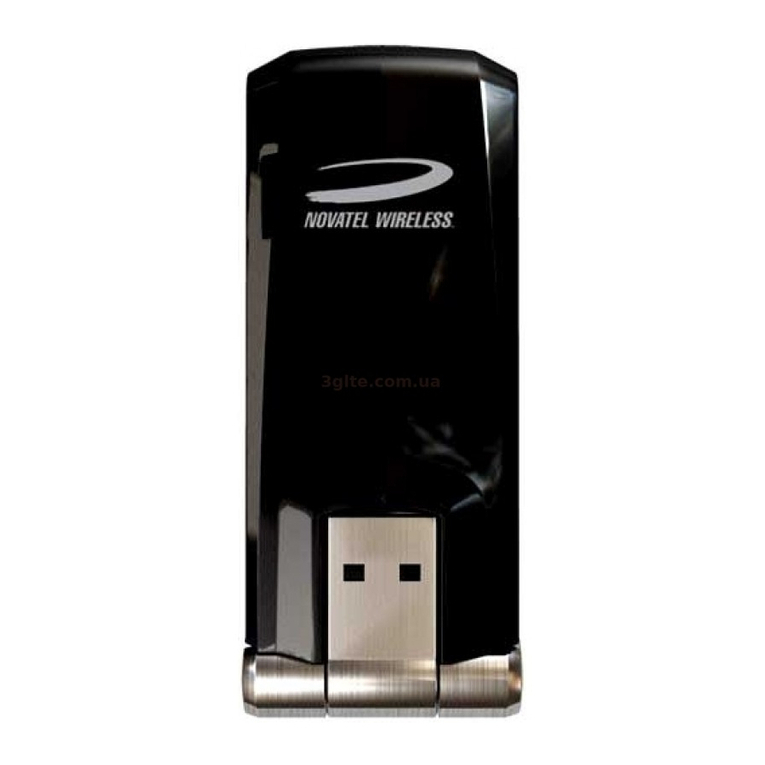
Novatel
Novatel Ovation MC996D quick start guide

Compaq
Compaq Lucent V.90 Quickspecs
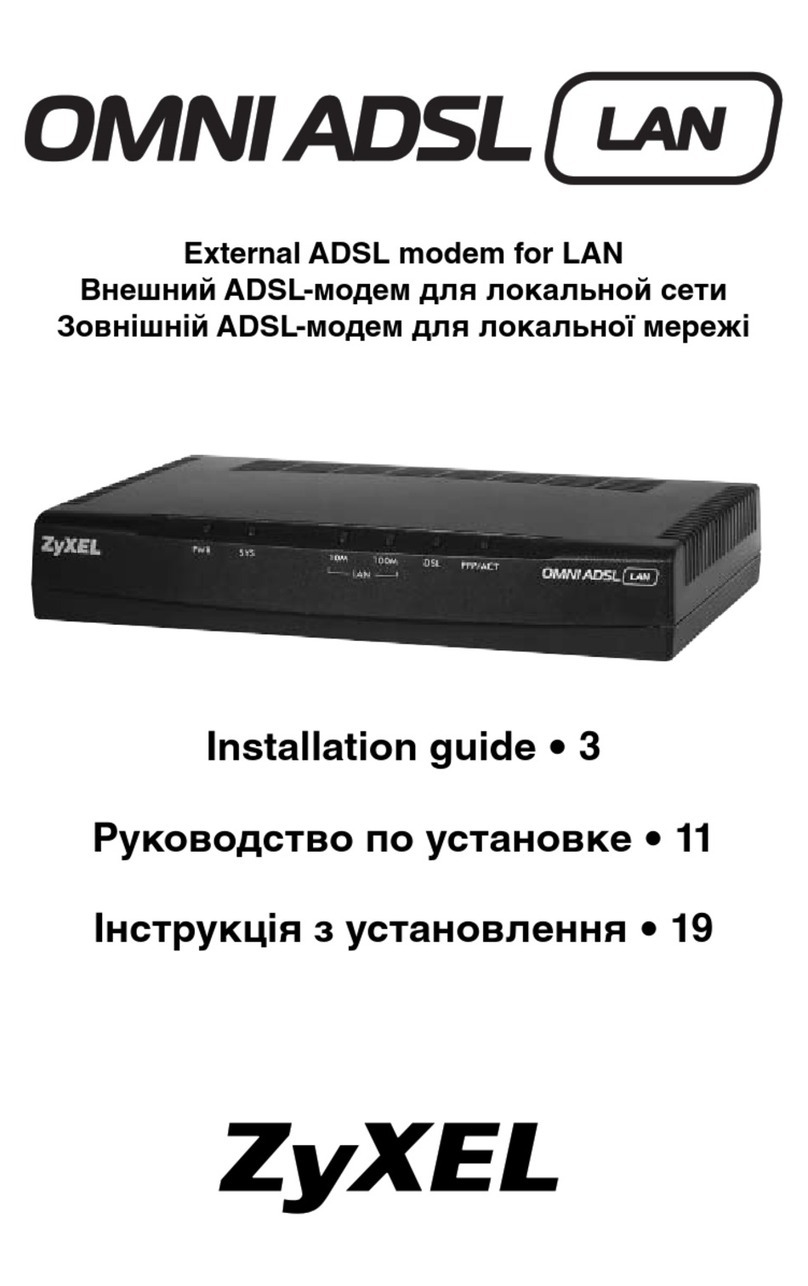
ZyXEL Communications
ZyXEL Communications Omni ADSL LAN installation guide
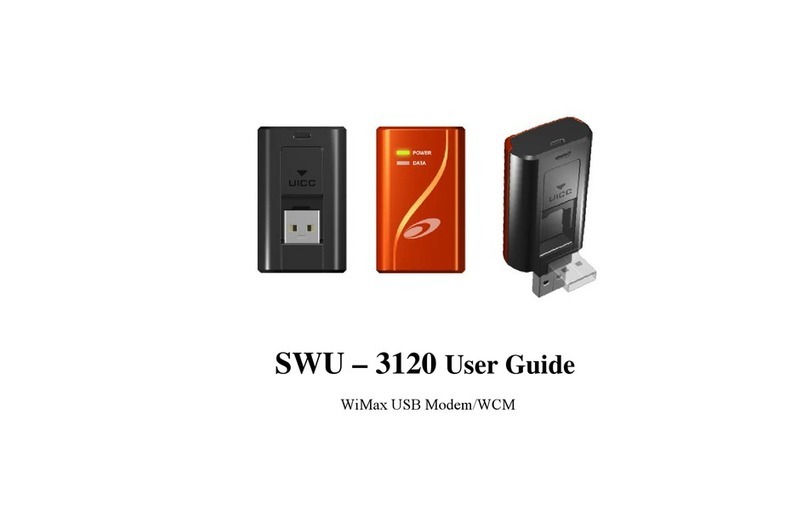
WiMAX
WiMAX SWU-3120 user guide
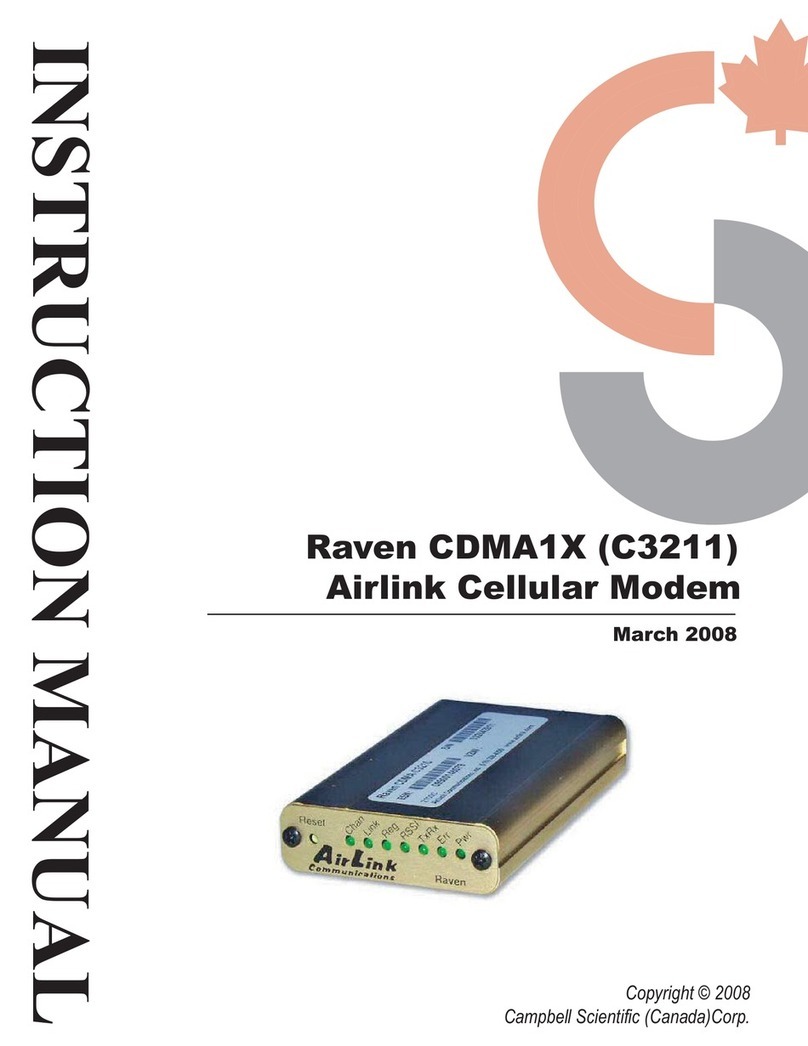
Campbell
Campbell Raven CDMA1X instruction manual
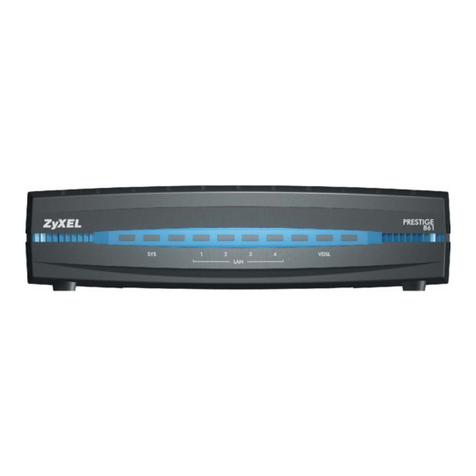
ZyXEL Communications
ZyXEL Communications PRESTIGE 861 Specifications
